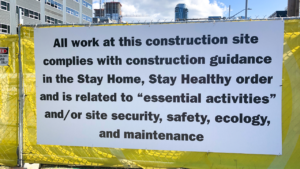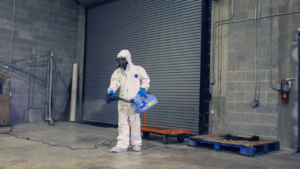How Businesses Survive During Pandemics
Managing a successful enterprise during a global pandemic is no easy feat. Shifting health and safety protocols, stressed and anxious staff and supply chain issues are just a few of the problems facing companies today. How businesses survive during pandemics is a question that has crossed many minds over the past year.
You know that safety is necessary for ensuring the health and wellness of your staff, your clients, and your company at large. Yet public health suggestions, government guidelines and public opinion change so quickly that it can be hard to establish a clear set of protocols for your own work place.
That’s why today, Racked Out is tackling this subject: Exactly how do essential companies manage their warehouse needs during the constantly shifting times of Covid-19?
We aren’t saying we have all the answers, or that our guidelines won’t require updating as our public health conditions change, but we’re offering some tips to our industry to help keep companies, their warehouses and of course, their people- safe and healthy.
Best Practices Are To Keep The Strictest Precautions For As Long As Possible
Yes, we know it’s likely the last thing you want to hear, but where health and safety is concerned we can never be too careful.
For the purposes of this article, we are using the health and safety guidelines laid out through the government of Ontario via Ontario.ca Workplace resources page, updated as of late April 2021.
What Are Your Responsibilities As An Employer To Provide A Safe Workplace During Covid-19?

Under Ontario Law, employers are obligated to take every reasonable measure to ensure the safety of their employees. Further, employees have the protected right to refuse work that is unsafe. For further information, the Ontario government has issued workplace safety guidelines outlined by Ontario public health.
Under OSHA, The Occupational Health And Safety Act, employers are required to:
– confirm workers understand the hazards of their workplace. They must be provided with accurate and updated information, instructions and supervisors, in order to allow them to work safely.
– confirm supervisors know what is required to ensure a healthy workplace to protect their staff.
– create workplace health and safety policies and procedures that ensure safety.
– ensure employees are following best practices
– ensure proper Personal Protective Equipment is available and that staff are trained for its’ proper use.
– ensure all reasonable measures are in place to protect workers.
Some of these guidelines include disinfecting commonly used surfaces, a minimum of twice daily with a disinfectant that has a clear Drug Identification Number (DIN). This DIN indicates it is confirmed for use by the government of Canada.
If these regulations seem intense and daunting, it’s understandable.
In short: Workplaces must provide workers with information, instruction, protective measures and supervision. This includes providing access to proper PPE, enforcing safe working practices and ensuring proper cleanliness with approved disinfectants.
PRO TIP: Need to mask your employees? Why not turn it into a marketing venture. Consider getting masks made for your employees that sport your company logo. This promotes safe work practices, strong branding, enhances company trust, and builds positive industry reputation.
What To Do If You’re Worried About Employee Exposure To Covid-19.

No one wants to think about it, but it is important to have a thorough plan in the event of Covid-19 exposure. Utilizing the guidelines from Ontario Public Health can help your team generate a comprehensive action plan in the event of exposure.
Based upon what is currently available (April 2021), the steps to addressing a COVID-concern at work could look like this example below.
Upon Detection Of Symptoms:
The Onatrio government requires employers to actively screen their employees at the start of each working day to assess possible symptoms. You can find an online screening tool on their website, along with many additional resources that can help your company plan their Covid-Safe Workplace Strategy.
Upon a worker showing symptoms of Covid-19, the employer should encourage them to stay home and contact their health care provider, their local public health unit, and Telehealth Ontario (1-866-797-0000). It may be in their best interest to get a Covid-19 Test.
At this stage it is necessary for the employer to conduct a thorough risk assessment of the working environment and/or job site to confirm who the employee may have come in contact with.
Discretionary Response Based On Risk-Assessment
Based on the risk assessment, the Employer may decide (or may be required to) send co-workers who were exposed to the initial worker home for two weeks with the request to self-isolate, self-monitor, and report any Covid-Like symptoms. Shutting down the worksite in order to clean and disinfect the site and equipment may also be advised or required.
As an employer, if you are notified that your worker has an occupational illness contracted through work exposure at the workplace, or that a WSIB claim has been filed, the employer must notify The Ministry Of Labour, Training and Skills Development in writing, within four days.
The Main Takeaway: Have A Comprehensive Plan For Addressing COVID-19

We have gone through some of the major protocols outlined currently by the government of Ontario. At first glance, these protocols may seem exhausting, and complicated. These complications can be mediated and simplified in advance, if your team has already put an internal framework in place. Safety-plans for your workplace can be created independently and adapted to your companies specific needs.
As an example, one such framework may look like this:
– All employees are required to be screened before starting work. Screening includes self reporting conditions and recording temperature at the start of each day.
– Employees are cross-trained on various tasks. In the event that one or more members become sick, their tasks can be transferred to others.
– Prepare and plan for sick days from your staff. Update your current internal sick day policy to reduce penalties for sick days. A sick employee who comes into work may risk harming your entire team.
– Simplify projects and teams. All work that can be done at home should be done at home.
– In the event that a person is sick, have an action-plan for thorough cleaning and evacuation. As an example: A worksite may be evacuated for a few hours, while a supervisor(s) in PPE disinfects the site. All employees are asked to get COVID-19 tests.
– Have discussions with clients up front and in advance of starting a job. Share with them your comprehensive Covid safety plan. Let them know in advance what additional protocols are in place. This lets’ your client know your commitment to safety, and allows workflow processes and potential hurdles to be discussed in advance.
– Have a plan for your worker to safely return to work.
Tips For Essential Workers To Help Slow The Spread Of COVID-19

If you, or a colleague is experiencing any COVID-like symptoms (such as a cough or difficulty breathing) the course of action should be to stay home, and alert your workplace supervisor. Important lessons in how businesses survive during pandemics can be learned.
For those working in essential capacities and trying to limit the spread of Covid-19, the following tips are also recommended by the government of Ontario:
- Wash hands thoroughly with soap and water, and with alcohol-based sanitizer if soap and water are not available.
- Use the crook of your covered elbow or sleeve if you must cough or sneeze
- Discard tissues immediately after use and wash hands thoroughly afterwards
- Avoid touching eyes, nose and mouth
- Limit and/or avoid contact with anyone feeling unwell
- Stay home as much as possible, and always when you are sick
- Limit or avoid contact with high-touch areas such as handrails, or public transit surfaces like hand-bars.
- Wash clothes as soon as you get home
- Notify your supervisor immediately if you are sick.
- Take every reasonable precaution to keep yourself, your loved ones and your workplace safe.
Any employee concerned about the health and safety adherence in their workplace has the right to refuse unsafe work. If you, or someone you know is concerned about safety in their workplace, and has already attempted to resolve the disputes internally, you can reach out to the Ministry Of Labour, Training and Skills Developments’ Health And Safety Contact Centre at 1-877-202-0008.
Conclusion (How Businesses Survive During Pandemics)
The Covid-19 Pandemic is a rapidly evolving situation, and circumstances and protocol surrounding best practices are changing constantly. Keeping up with the latest developments can feel overwhelming and stressful, especially when the safety of your workers and the well being of your company is at risk.
It is normal and understandable to feel emotional and practical exhaustion during such unprecedented times. Thankfully, accessing and understanding the up-to-date government guidelines can help give you peace of mind, while also ensuring the safety of your staff.
Most importantly, having a comprehensive action plan for working safely, and addressing safety concerns (such as illness or COVID symptoms) when they arise can help calm your company in turbulent times, and ensure safety for the future.
Additional Sources:
What Workers and Employers Can Do to Manage Workplace Fatigue during COVID-19
